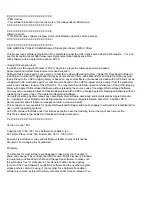
28
[root@localhost ~]# hwclock –-systohc
Run
the
following
command
to
check
whether
the
new
date
and
time
are
correct:
[root@localhost ~]# clock;date
Performing
Service
Operations
Viewing
service
status
[root@localhost ~]# vmserver.sh status
Pgsql is running
Img is running
Mcserver is running
Vmserver is running
Adapter is running
Sgserver is running
serversnmpd is running
DiskReadOnlyCheck is running
Vmdaemon is running
The
service
status
is
either
running
or
stopped
.
If
the
status
of
a
process
as
shown
above
is
displayed
as
stopped
,
you
need
to
restart
the
service
manually.
For
details,
refer
to
“
Restarting
the
service
”.
If
an
executable
file
of
the
server
is
deleted,
or
if
its
executable
permission
is
modified,
a
"does
not
exist"
message
will
be
displayed,
indicating
that
the
service
does
not
exist.
In
that
case,
you
need
to
reinstall
the
software.
Starting
the
service
The
VM8500
‐
E
service
automatically
starts
when
the
software
installation
is
completed.
To
start
the
service
manually,
use
the
following
command:
[root@localhost ~]# vmserver.sh start
Stopping
the
service
To
stop
the
service
manually,
use
the
following
command:
[root@localhost ~]# vmserver.sh stop
Restarting
the
service
CAUTION!
Restarting
the
service
will
also
restart
the
database
and
may
cause
service
exceptions.
To
restart
the
service,
use
the
following
command:
[root@localhost ~]# vmserver.sh restart
Viewing
System
Logs
System
logs
are
stored
in
the
/var/log/imoslog
directory.
To
search
the
directory
for
a
log
file,
use
the
ls
command.
[root@localhost ~]# cd /var/log/imoslog
[root@localhost log]# ls
To
view
the
content
of
a
log
file,
run
the
tail
command:
Содержание VM8500-E
Страница 1: ...VM8500 E Video Management Server Quick Guide Manual Version P100 20140307 ...
Страница 17: ...11 Figure 2 4 Installed device in the cabinet ...
Страница 44: ...BOM 3101C03M ...










































